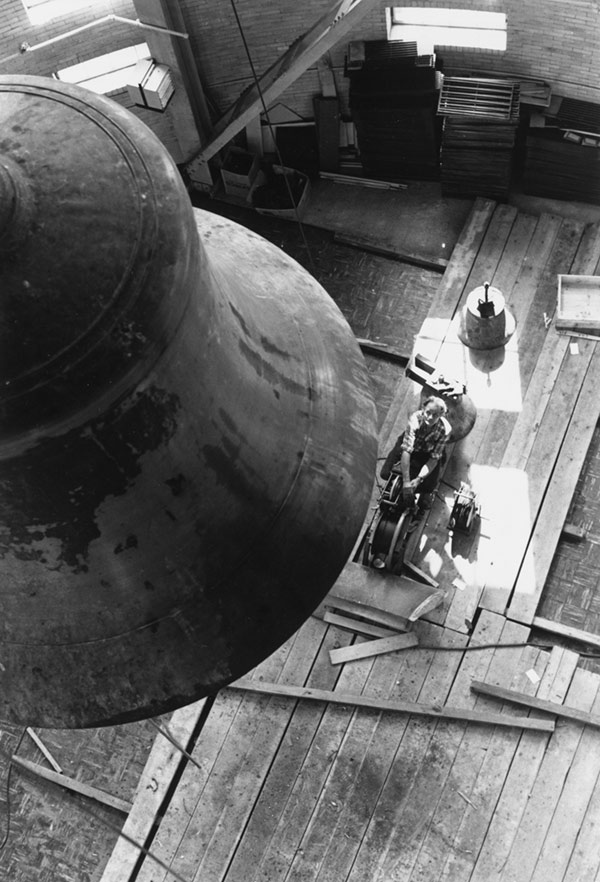Ask the Archivist: What’s for Lunch?
 BETTER BELLS: Since the iconic musical instrument was originally installed in the tower of Rush Rhees Library, the Hopeman Memorial Carillon has been renovated and expanded, including a 1973 project that replaced the original 17-bell chime with a 50-bell carillon. (Photo: University Libraries/Department of Rare Books, Special Collections, and Preservation)
BETTER BELLS: Since the iconic musical instrument was originally installed in the tower of Rush Rhees Library, the Hopeman Memorial Carillon has been renovated and expanded, including a 1973 project that replaced the original 17-bell chime with a 50-bell carillon. (Photo: University Libraries/Department of Rare Books, Special Collections, and Preservation)An alumni letter in the recent Campus Times tribute to the late Miguel Rodriguez ’96 mentioned a Rochester dish from the ’90s called a “Squealy Gobbler.” Have you ever heard of that? Was it the Mel Burger of the Clinton era?—Daniel Gorman Jr. ’14, PhD student in history
Rare is the generation of college students that recalls, and admits to, a beloved dining services offering. Rarer still is the favorite with staying power beyond the waistline. The Mel Burger, with its ever-better secret sauce, has been on the menu since 2005. By contrast, the Squealy Gobbler was available in the Wilson Commons Pit only for a few years in the mid-to-late-1990s. Its ingredients and preparation were a University Archives mystery that only alumni from that era could solve. A Facebook query posted by Alumni Relations sparked a sizzling online conversation, with the sandwich described by Peter Schenck ’96 as “Turkey, ham, cheddar on the grill, then onto a sub roll with BBQ sauce . . . Squealy (ham) Gobbler (turkey) . . .”
The University Archives has a jar of Mel Sauce preserved for the ages but always welcomes memories of favorite dishes, staff, and dining companions.
My great-great-great grandfather started Verdin Bell in 1842, but there was only one early American bell foundry that ever learned how to cast a true carillon bell, Meneely & Company of Watervliet, New York, founded in 1826. Meneely cast their first chime of bells in 1854, and in 1930, cast 17 bells for the University of Rochester in Rush Rhees Library. Can you tell me what happened to the original bells, which were replaced by a carillon in 1973? The original chime was unique because it was so large.—Tim Verdin, president, Verdin Bell Company, Cincinnati, Ohio
A. W. Hopeman and Sons were the general contractors for many of the University’s buildings, including the Eastman School of Music and Eastman Theatre, and the original River Campus buildings. The Hopeman Family gave the chime of 17 Meneely bells as the literal crowning touch on the library tower. The bells were heard weekly for many years, played by Professor John Rothwell Slater and Robert Metzdorf ’33, ’39 (PhD), among others.
To expand the musical range of the instrument, two additional bells were purchased from Petit and Fritsen in 1956. In 1973, plans were made to replace the chime with a full carillon, and a contract was signed with the bell foundry Eijsbouts of Asten, the Netherlands.
The weight of the new carillon of 50 bells was 6,668 pounds, much lighter than the original set. What to do with almost 18.5 tons of old bell-metal? According to correspondence between the University’s assistant treasurer, Bruce Wolfanger, and the Eijsbouts staff, the component metal of the bells had greater value in Europe than in the United States even after shipping. Eijsbouts kept the 11 largest bells, and gave the University a discount on the cost of the carillon. The very largest bells, including a low B-flat weighing 7,800 pounds and 72 inches in diameter, were too big to remove from the tower without cracking them into pieces.
But the smaller bells still had life in them—and sentimental value. Also in 1973, Christ Church in Rochester was looking to replace its bells, and it appears that arrangements were made for the church to receive six smaller bells at the cheaper, United States cost of the metal.
Albert A. Hopeman Jr., grandson of Arendt W. Hopeman, in whose honor the original chime was donated, requested and received the smallest of the original bells, which at 24 inches in diameter weighed 300 pounds. Retained for the Archives was the small keyboard used to play the chime, which was joined in 2017 by a selection of smaller clappers from the carillon that were replaced during a 2016 renovation.

